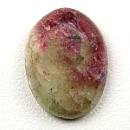|
|
||||||||||||||||
|
||||||||||||||||
|
||||||
|
|
|
|
Leucophoenicite
|
|
| | |
| Discovered in 1897; IMA status: Valid (pre-IMA; Grandfathered) | ||
|
| ||
|
Chemistry |
|
|
| |
|
Mn2+7(SiO4)3(OH)2 | |
|
|
Manganese Silicate Hydroxide |
|
Molecular Weight: |
694.83 gm |
|
Composition: |
Manganese |
55.35 % |
Mn |
71.47 % |
MnO |
|
|
Silicon |
12.13 % |
Si |
25.94 % |
SiO2 |
|
|
Hydrogen |
0.29 % |
H |
2.59 % |
H2O |
|
|
Oxygen |
32.24 % |
O |
|
|
|
|
|
100.00 % |
|
100.00 % |
= TOTAL OXIDE |
|
|
|
||||
|
Classification |
|
|
| |
|
Silicates (Germanates) | |
|
8/B.04-90 | |
|
|
9 : SILICATES (Germanates) |
|
Related to: |
Humite Group. Dimorph of Manganhumite. |
|
Members of Group: |
Humite Group: Chondrodite, Clinohumite, Humite, Hydroxylchondrodite, Hydroxylclinohumite, Norbergite |
|
Varieties: |
None |
|
Synonyms: |
ICSD 15176, PDF 22-1168 |
|
|
|
|
Crystal Data |
|
|
|
|
|
Crystals rare, typically slender, prismatic, elongated and striated || [010], to 8 mm; in isolated grains or granular massive. |
|
|
On {001}, common, contact or interpenetrant twins, lamellar. |
|
|
|
|
|
Physical Properties |
|
|
|
|
|
Imperfect on {001} |
|
|
Irregular/uneven |
|
|
Brittle |
|
|
5.5 - 6.0 |
|
|
3.848 (g/cm3) |
|
|
None |
|
|
Not Radioactive |
|
|
|
|
|
Optical Properties |
|
|
|
|
|
Brown to light purple-red, raspberry-red, deep pink to light pink; rose-red to colorless in thin section |
|
|
Transparent to translucent |
|
|
Vitreous |
|
|
1.751 - 1.782 Biaxial ( - ) |
|
|
0.031 |
|
|
Slight; r > v |
|
|
Faint; rose-red parallel to {001}; colorless perpendicular to {001} |
|
|
|
|
|
Occurances |
|
|
|
|
|
Geological Setting: |
A late-stage hydrothermal or contact zone mineral in veins and skarns in a metamorphosed stratiform Zn-Mn orebody (Franklin, New Jersey, USA). |
|
Common Associations: |
Willemite, Franklinite, Calcite, Vesuvianite, Garnet, Sussexite, Rhodochrosite, Pyrochroite, Tephroite, Sonolite, Jerrygibbsite, Glaucochroite, Manganosite, Copper, Zincite (Franklin, New Jersey, USA); Barysilite, Spessartine, Vesuvianite, Barite, Copper, Hausmannite (Kombat mine, Namibia). |
|
Common Impurities: |
Fe, Mg, Zn, Ca, Na, K, H2O |
|
Co-Type Localities: |
•
Franklin Mine, Franklin, Franklin Mining District, Sussex County, New Jersey, USA
|
|
Year Discovered: |
1897 (identified as a new mineral species in 1899) |
|
View mineral photos: | |
|
|
|
|
More Information |
|
|
|
|
|
| |
|
|
|
|
Leucophoenicite was discovered by J. J. McGovern (?-1915) at the Franklin Mine in New Jersey. For many years McGovern was in charge of the picking table at the head of the mine shaft and was one of the foremost collectors of Franklin minerals and added much to the knowledge of Franklin mineralogy. The mineral McGovernite was named in his honor in 1927 by American mineralogist and crystallographer Charles Palache (1869-1954) and chemist Lawson Henry Bauer (1888-1954). The specimen McGovern found at the Franklin Mine was given to American geologist Charles Hyde Warren (1876-1950) in 1897. It was first thought to be Clinohedrite deeply colored by manganese, but was identified as a new mineral species by Warren and Samuel Lewis Penfield (1856-1906) in 1899. The crystallography of Leucophoenicite was first described by Charles Palache in 1910, as Penfield and Warren were unable to determine the crystal system. Leucophoenicite was named in 1899 by Warren and Penfield from the Greek words λευκοσ (leukos) meaning pale and Фοινιζ (foinis) meaning purplish red in allusion to its common color. Leucophoenicite
distribution: at
Franklin, Sussex County, New Jersey, USA. From Pajsberg,
Värmland, Sweden. In the Valsesia-Valtournanche
area, Val d'Aosta, Italy. In the Kombat mine, 49 km
south of Tsumeb, Namibia. From Hotazel, near Kuruman,
Cape Province, South Africa. |
|
|
We
have not photographed our Leucophoenicite
gems yet. Please
check back soon. |
